Journey to Gourdlandia: A gourdgeous way to spend a fall day
by D.E. Bentley –
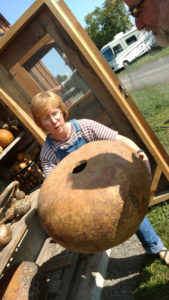
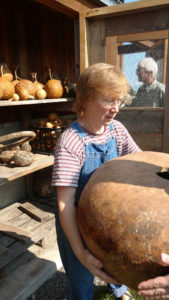
Creating from gourds has become BIG news. There are now gourd societies, gourd magazines, gourd clubs and tens of thousands of gourd enthusiasts. We recently had the opportunity to explore one Finger Lakes gourd artist’s studio and classroom space, and redeem a Gourdlandia gift certificate given to me by my sister. Our gourdgeous journey south to learn more about these incredible plants made for a lovely fall drive, as the leaves, changing with the season, drifted to the ground in a cascading rainbow of colors.
Gourds are members of the family Cucurbitaceae, which we are all familiar with as food. Cucumbers are in this family as are summer and winter squashes and melons. One of the most visible examples this time of year is pumpkins carved into jack-o-lanterns.
Humans’ creating useful objects out of gourds is nothing new. Subspecies of the bottle gourd, Lagenaria siceraria, have been found in archaeological sites dating 10,000 years BCE, or earlier. Historical examples of the utilitarian use of gourds to make vessels, tools and musical instruments, as well as their use for artistic and spiritual ceremony are well documented.
What is new is the innovative and creative ways in which people are using gourds and other Cucurbit family fruits in utilitarian and expressive art and culinary inventions.
Even the jack-o-lantern has been turned on its head with new and creative designs that go way beyond the scary, toothed spirit -haunting faces of the past.
Gourdlandia is located in EcoVillage, a destination all by itself for those interested in alternative, sustainable lifestyles (http://ecovillageithaca.org/visit/). Add to this, the journey from lake points north and you have the makings of a memorable fall adventure. Traveling south on 96A and 96 from Geneva offers breathtaking views of the countryside overlooking Seneca and Cayuga lakes. Scattered with wineries, breweries, eateries and farm fare, including piles of pumpkins, this journey with its host of quaint and expansive roadside offerings is almost enough distraction to forget the destination.
Connecting up with Route 79, you will begin winding your way down the hill toward Ithaca, worth an overnight stay at the very least. Turning right into Rachel Carson Way, named after the well known eco-activist and author of Silent Spring, the first thing you will notice is the roadside bus stop with the living roof. Continue to Gourdlandia, #77 Rachel Carson Way, on the left – with its rooftop cupola and large welcoming porch. You can’t miss it.
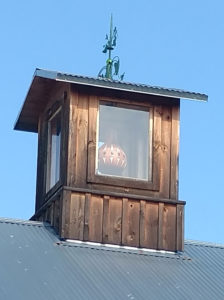
Turning to the left of the Gourdlandia building, we parked. As we looked out at the enticing arbor of gourds and the cupola rooftop lantern, gourd artist Graham Ottoson greeted us warmly. As a long time Ithaca resident, I had met Graham previously. I had even had the pleasure of pounding a rooftop beam or two into place when she built her EcoVillage timber frame / straw bale home. I was also aware of her previous life as a midwife. Thanks to a passion ignited by a happenstance stop at a roadside gourd stand, breathing new life into gourds has taken the place of her earlier lively vocation. She now spends her time creating original and captivating designs in a shop custom designed and built by Otto Ottoson, her partner in gourds, and life – he was out washing dried gourds as we headed toward the entrance and made our way under the arbor.
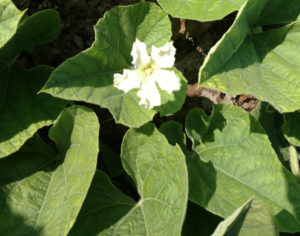 The outside of the Gourdlandia building features gardens of gourds. Plants hang from the wrap-around arbor and run along the grounds that surround the building. They are beautiful plants, with massive leaves and impressive white flowers. The fruits come in all shapes and sizes, and an eclectic arrangement on drying racks along the building’s back wall caught our attention.
The outside of the Gourdlandia building features gardens of gourds. Plants hang from the wrap-around arbor and run along the grounds that surround the building. They are beautiful plants, with massive leaves and impressive white flowers. The fruits come in all shapes and sizes, and an eclectic arrangement on drying racks along the building’s back wall caught our attention.
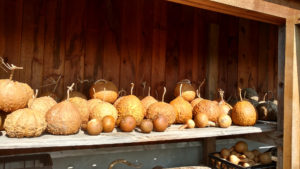
Most of the ornamental gourds used for utility and art are from the group Lagenaria siceraria, a name that means drinking vessel, one of the many uses for these hard-shelled gourds. This group includes gourds with common names like “speckled swan,” “bottle,” “dipper”, “penguin,” “canteen,” “birdhouse” or “powder horn” that describe characteristics or possible uses. Some of the gourds we saw at Gourdlandia were tiny enough to be made into small bottles, hung around the neck filled with essence. Others were massive bowl-shaped “bushel” gourds.
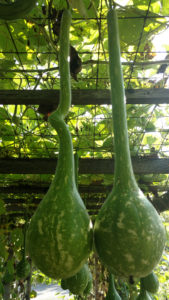
Each plant, even of the same type, has its own characteristics. Some of the gourds can be grown easily in a season, planted directly outside. Others, such as the speckled swan gourds, have longer growing seasons that require growers in this part of the world, and country, to start the plant inside weeks before the last frost in the spring.
Growing the gourds is where the art begins. Care in cultivation helps to create strong, thick shells and uniquely shaped fruits. Some of the gourds are also manipulated as they grow to accentuate desirable traits, an early stage in the creative work of the gourd artist. Once mature, the gourds are dried, with drying times variable – from a month to months – depending on the size and type of gourd. Once dried, the gourds are scrubbed on the outside to ready them for the artist’s hand. The variable surface textures of the dried gourds, including molding that creates a mottle pattern, adds to the natural beauty of the finished pieces.
Stepping inside of the Gourdlandia building, we get our first glimpse of some of the amazing things that can be created from this simple, humble plant. There are lamps of all types lining the shop store shelves; globe lamps, night lights and lampshades in a variety of shapes. All are intricately carved with saws and drills, allowing light to spill gracefully out. There are also vessels, clocks and whimsical characters, all crafted from gourds. Graham is drawn most to lamps, and has created hundreds, including the large lantern that graces the building’s cupola.
Creating lamps is a multi step process. Graham begins by cutting into the gourd and removing the dried seeds and meat from the inside. She then scrapes the interior surface clean. Depending on what the gourd will become, next steps include dyes or paints, piercing the surface with saws and drills, burning the surface and waxing the finished surface. Gourds may be combined or embellishments added for utilitarian – as is the case with light fixtures, clock works and musical instruments – or aesthetic purposes. Since each gourd (and artist) is different, no two creations are ever the same. Choosing the perfect gourd for a project is an important step and we were ushered up into the attic area where a plethora of gourds awaited. I chose a pear shaped gourd and my travel partner chose a small bowl shaped one.
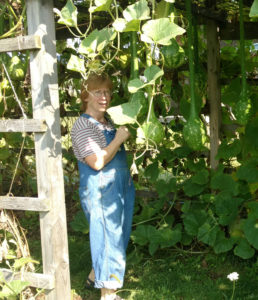
Graham Ottoson’s love and experience with gourds has morphed from an artistic exploration into a career. In addition to creating art from gourds, she now offers a wide range of classes, and private specialty workshops, to other interested artists and crafters, contributing to the gourd creators’ community. She is also one of the founding members of the New York State chapter of the American Gourd Society whose goal is to promote “interest in all activities relating to gourds: cultivation and artistic shape manipulation, historical uses, gourd show competition, craftwork, and artistic decoration.” It is immediately evident that Gourdlandia contributes to this goal, with opportunities for students to make globes, night lights, bowls rimmed with pine needles, covered boxes, baskets and clocks. There are also classes in techniques, such as wax resist or pyrography. Classes can be catered to the students interests and specially designed creating “parties” can be set up for groups. Spur of the moment visitors looking to jump right into the art of gourds can create a “holey night light” or a “gourd necklace” while exploring the site’s shop and grounds.
After exploring a bit more and seeing some of the preliminary process of gourd preparation, we got to work on our own projects. When I called to schedule, I shared our desire to learn about the tools and techniques of pyrography – burning designs into a surface. Graham was very accommodating, and we quickly set up a private time to spend our creative gift certificate and learn more. After watching Graham’s demonstration, we retrieved our chosen gourds and got to work. She helped us mark and cut the tops and guided us in scraping the interiors. I was initially hesitant to scrape vigorously as I removed the dried remnants from the interior of the gourd but found that the gourds were much stronger than I imagined.
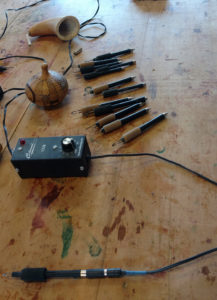
We then spent some time learning about and using the burning handles and tips. My partner is more systematic in his approach to learning new things, whereas I like to just dive in and see what the tools can do. Graham was incredibly patient, recognizing and fostering our creative directions while showing us shortcuts and effective techniques.
As it so accurately is worded on the Gourdlandia Website “About” section, “It’s a fine art, to enhance something that is already perfectly ‘gourdgeous.’ From lamps to vases, dollhouses, nightlights and more, visitors to Gourdlandia are delighted at what can emerge from a gourd. Come enjoy the viney trellises, heavy with potential art… and if you care to try your hand at gourd crafting, let me know!”
Our experience meshed so perfectly with this description. It is hard to imagine a more satisfying and interesting journey for a fall day, a pleasant mix of artistic inspiration combined with foliage fancying and eco-tourism that all begins with this incredible family of plants.
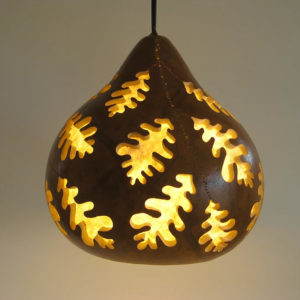
To see more images of what Gourdlandia has to offer go to www.gourdlandia.com. Lamps and other gourd art can be purchased at Gourdlandia, ithacamade, Gallery 54 in Skaneateles or by contacting Gourdlandia by phone at (607) 277-0589.